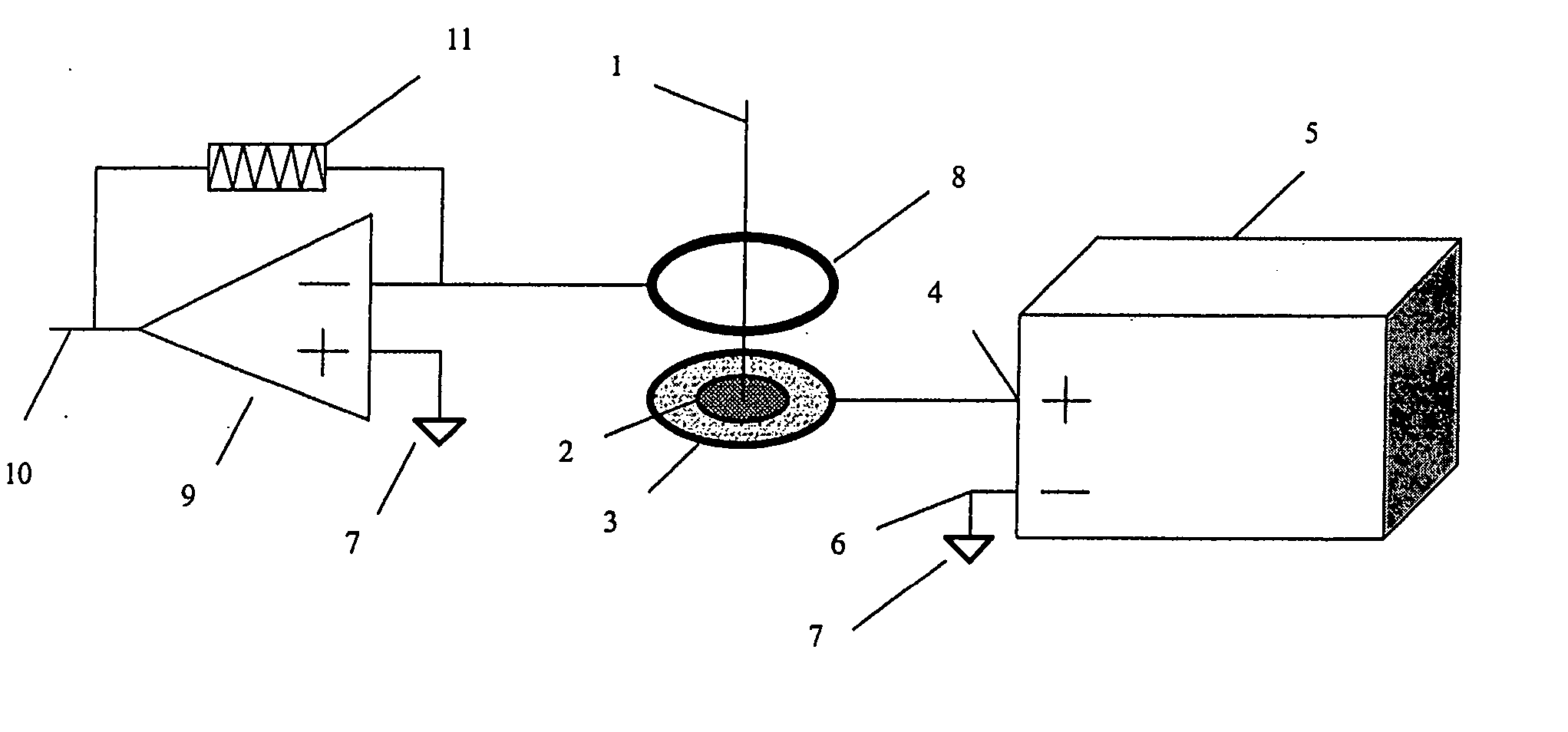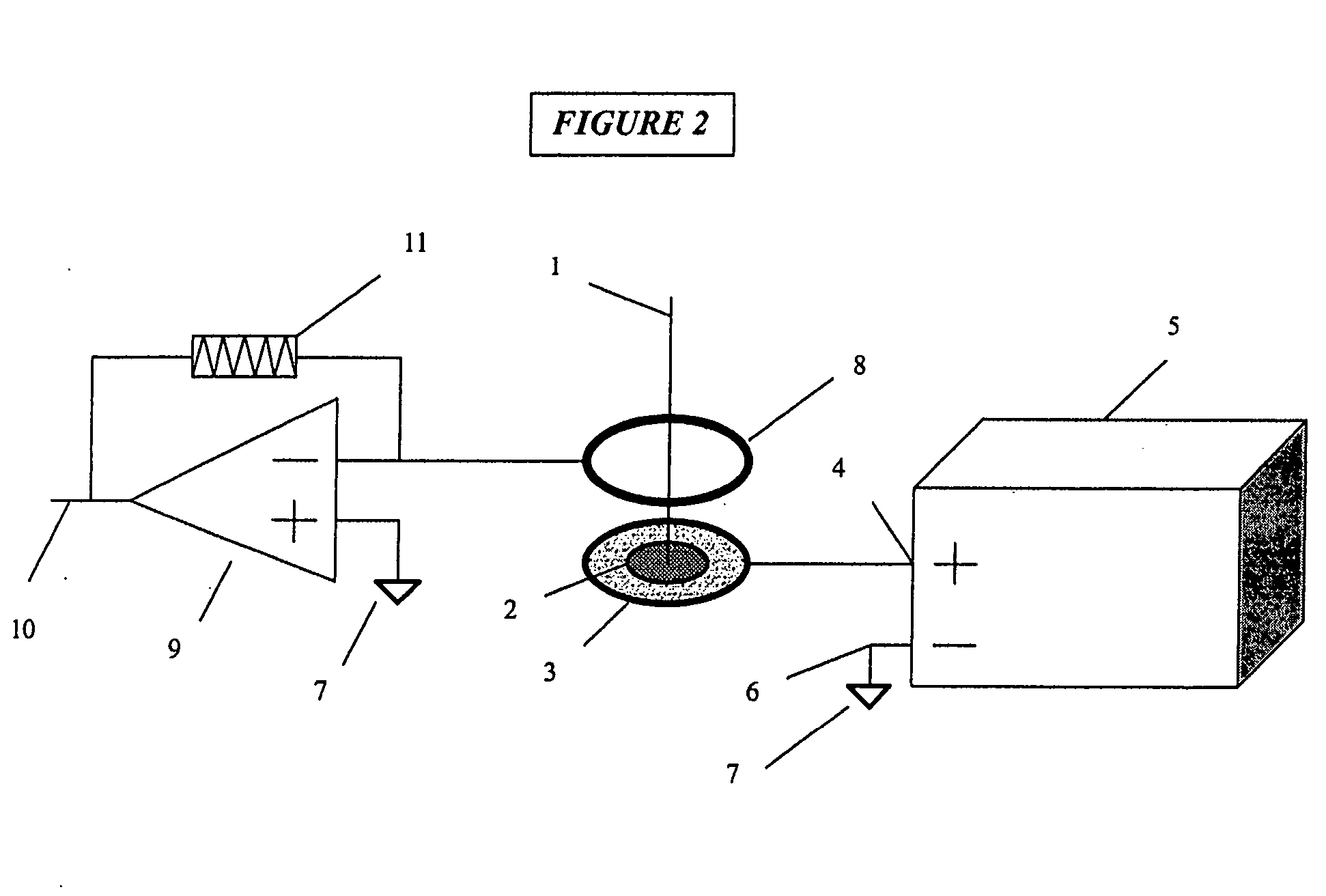Laser ablation feedback spectroscopy
a technology of feedback spectroscopy and laser ablation, which is applied in the direction of manufacturing tools, metal working equipment, welding/soldering/cutting articles, etc., can solve the problems of workpiece surface contamination, interference with optical or fluidic properties, and debris may be extremely difficult to remove from the surface of some materials
- Summary
- Abstract
- Description
- Claims
- Application Information
AI Technical Summary
Benefits of technology
Problems solved by technology
Method used
Image
Examples
first embodiment
[0030] the present invention is depicted in FIG. 1. The optical axis 1 of a laser ablation device (not shown) is centered on a work-piece 2, which is retained in an electrically conductive chuck or holding fixture 3. The work-piece 2 and holder 3 are connected to a DC power supply 5 by a wire 4 attached to its positive output. The negative output of power supply 5 is connected by another wire 6 to earth ground 7. This circuit places a positive voltage potential on the work-piece 2 surface. A circular electrode ring 8 connected to earth ground 7 is located above the work-piece 2 and centered about the optical axis 1; this establishes an electric field above the work-piece such that positively ionized particles from the laser ablation plume are attracted to the electrode ring. Furthermore, any positively charged particles from the ablation plume that escape attraction to the electrode ring (by virtue of excess kinetic energy) are repulsed from the positively charged surface of the wor...
second embodiment
[0032] the invention is shown in cross-section in FIG. 3. The work-piece 2 is supported in the holder 3. A first conductive mask or film 12 is located in intimate contact with the upper surface of the work-piece 2, and retained by any method such as an adhesive, clamps or gravity. The first conductive mask or film 12 is connected by wire 4 to the positive output of a DC power supply 5, whose negative output is connected to earth ground 7. An insulating mask or film 13 is applied to the upper surface of the first conductive mask or film 12. A second conductive mask or film 14 is applied to the upper surface of the insulating mask or film 13 and connected to earth ground 7. As the laser ablation proceeds along the optical axis 1, it ablates through the successive layers of masks 14, 13, 12 and then commences to ablate the work-piece 2. The positively ionized particles in the ablation plume are repelled by the positively charged first conductive film or mask 12 on the upper work-piece ...
fourth embodiment
[0034] the invention is shown in FIG. 5. A permanent magnet 17 is located near the optical axis near the ablation site on the work-piece 2. The magnetic field deflects the charged particles in the ablation plume through a curved path 18, whose radius and direction are dependent on the strength and geometry of the magnetic field, the mass / charge ratio of each particle in the plume, and the initial velocity vector of each particle. The same result is achieved as shown in FIG. 6, in which a DC electromagnet 19 energized by windings 20 creates the magnetic deflection field.
PUM
| Property | Measurement | Unit |
|---|---|---|
| electric field | aaaaa | aaaaa |
| voltage potential | aaaaa | aaaaa |
| mass analyzer | aaaaa | aaaaa |
Abstract
Description
Claims
Application Information
 Login to View More
Login to View More - R&D
- Intellectual Property
- Life Sciences
- Materials
- Tech Scout
- Unparalleled Data Quality
- Higher Quality Content
- 60% Fewer Hallucinations
Browse by: Latest US Patents, China's latest patents, Technical Efficacy Thesaurus, Application Domain, Technology Topic, Popular Technical Reports.
© 2025 PatSnap. All rights reserved.Legal|Privacy policy|Modern Slavery Act Transparency Statement|Sitemap|About US| Contact US: help@patsnap.com



